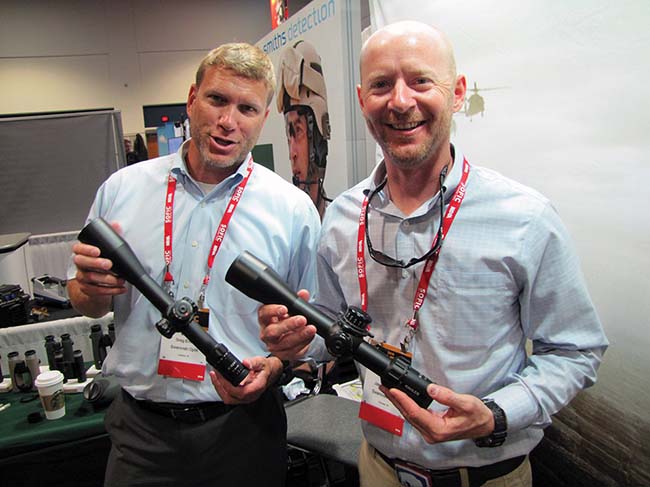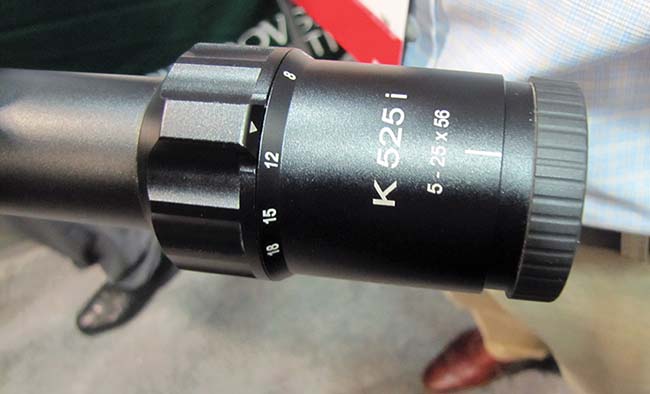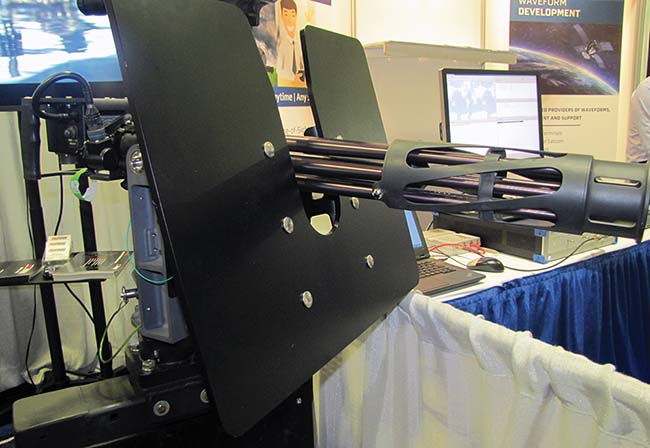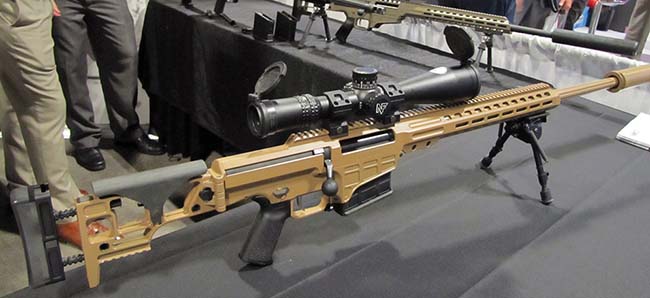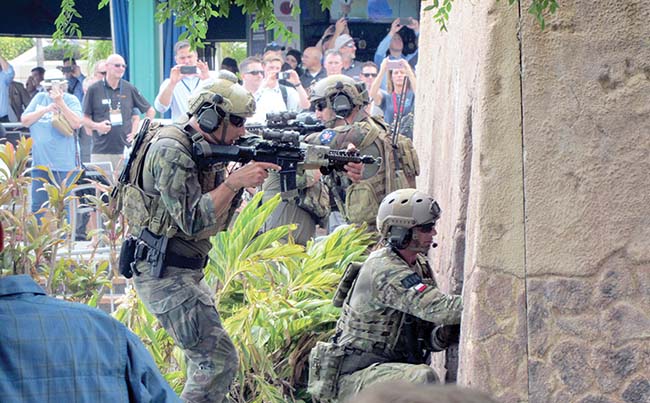
2018 Special Operations Forces Industry Conference and Exhibition
The United States Special Operations Command (USSOCOM) is a unified command whose task is to oversee the special operations components of the U.S. Army, Marine Corps, Navy and Air Force. Headquartered at MacDill Air Force Base in Tampa, Florida, the USSOCOM conducts a yearly industry conference with the goal of maintaining its edge in the military equipment supplied to its forces. Organized by the National Defense Industrial Association (NDIA), the objective of this four-day conference is to capitalize on collaboration opportunities with focused engagements to eliminate gaps, threats and risks to the Special Operations Forces (SOF) community.
The conference featured numerous opportunities for attendees to learn how to do business with USSOCOM, including through Small Business Innovative Research (SBIR) Proposals, Cooperative Research and Development Agreements (CRADA), the Technical & Industrials Liaison Office (TILO) and others. Representatives from C4, Fixed Wing, Maritime, Rotary Wing, SOF Warrior, Special Reconnaissance, Surveillance and Exploitation, J4 Logistics and Science & Technology were present to showcase their capability gaps.
In addition to the new technologies offered by more than 400 exhibitors, the conference featured an International Special Operations Forces (ISOF) capabilities demonstration, where U.S. SOF participated in a rescue operation with ISOF partners from seven other countries. In the demonstration, a high value captive—in this case the mayor of Tampa—was held captive by “terrorists” on a large yacht and then moved to a bunker adjacent to the convention center. To the joy of the Tampa public, an exciting assault on the yacht was conducted by divers, parachutists, helicopter-borne troops and riverine craft. The mayor was safely recovered.
In addition to the capabilities demonstration, the exhibitors offered a multitude of interesting products.
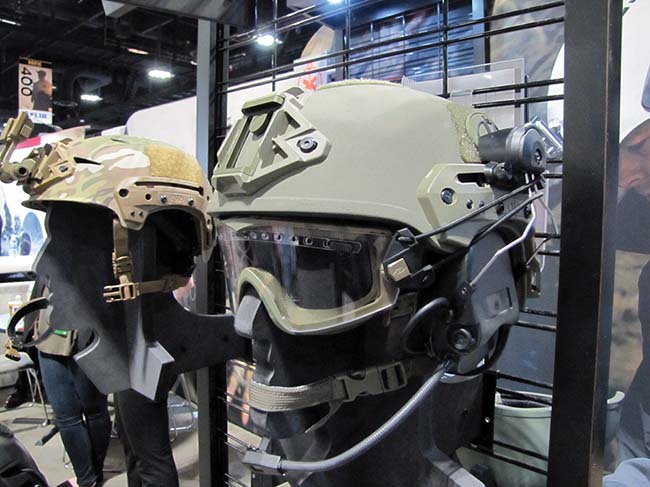
Team Wendy
Team Wendy has a long history with the military, producing combat helmet liners for both the Army and Marines. This year, the company was proudly showing off their newest products: the Exfil® ballistic helmet and ballistic visor. The helmet offers National Institute of Justice (NIJ) level 3A protection and is fitted with the Wilcox Industries shroud. The Exfil® helmet offers a 15% weight reduction over the older model. For increased wearer comfort, these helmets feature the CAM FIT retention system, which evenly changes the lengths of all the head straps with a single adjustment.
Swarovski
Renowned for their high-quality optics, Swarovski displayed their newest rifle scope, which is intended to replace their 6-24x model. The new K525i 5-25×56 variable scope is being offered by Swarovski-owned Kahles. It features an illuminated reticle popular in SOF markets. Kahles is famous for its robust designs, and such features as the rugged parallax adjustment incorporated into the elevation turret of the K525i contribute to this reputation further. Locating parallax adjustment in the center allows the windage adjustment to be located on either the right or left side, at the preference of the customer.
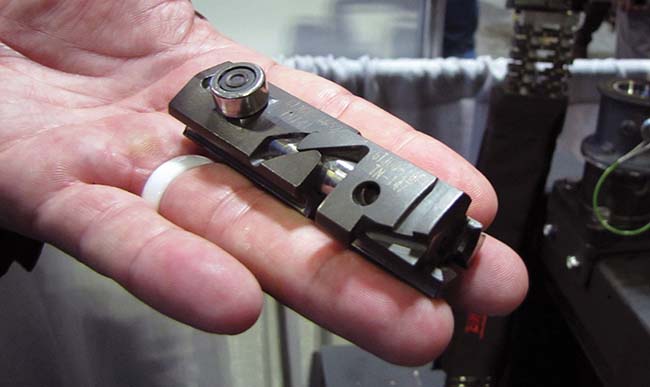
Profense
Having only been in business for three years, Profense offers 5.56mm and 7.62mm Miniguns. The Profense guns boast some innovations that take them beyond the Vietnam War-era M134 models. Profense has added an ammo boost feature to mechanically feed ammunition up from the ammunition box, where a newly designed belt-holding pawl prevents the ammunition from dropping back into the box. They have redesigned the feed sprocket and have a built-in ammunition gauge to let the gunner know how much ammunition remains. Clearing at the end of a burst is accomplished with a de-clutching feeder that stops the ammunition from feeding while letting the few remaining rounds in the feeder fire and eject. Feed timing is maintained so that rounds are properly fed to each bolt when the next burst is fired. This is in deep contrast to the old Vietnam M134, which employed diversion clearing, where 7–10 live rounds were diverted from the gun and dumped overboard at the end of each burst. Profense Miniguns have been sold to 28 countries but have not yet made it into the U.S. military.
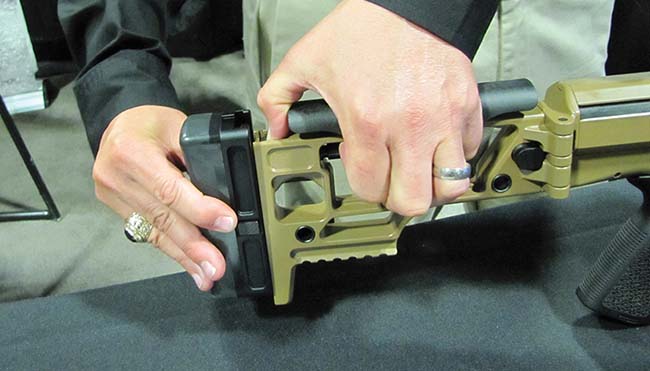
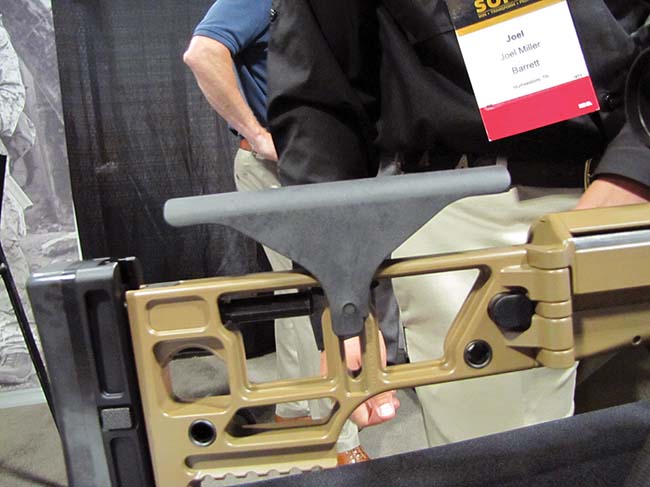
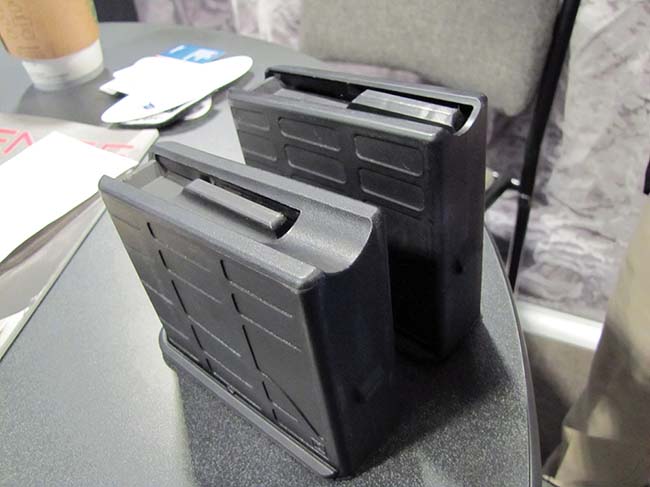
Barrett
Hot on the trail of the Advanced Sniper Rifle (ASR) program, Barrett will be a tough contender with their Multi-Role Adaptive Design (MRAD). The MRAD is a multi-caliber system that is easily transformed in the field from one caliber to another. These include the .338 Norma Magnum, .300 Norma and 7.62mm NATO to meet the ASR requirement. In total, there are eight different calibers available with the system. The MRAD is suppressor-capable and has a long monoblock Picatinny rail to maximize accuracy with the free-floating barrel. The folding stock and adjustable cheek piece can be swapped over to offer a flat side or rounded side, depending on which is more comfortable for the operator.
Each changeover kit comprises a barrel, bolt head and magazine. The magazine bodies are alike, but the followers are specific to the type of ammunition being used. To change caliber in the field, the operator switches out parts and brings the bolt forward to the locked position while the barrel is loose. At this point, the barrel retaining screws are socked in and headspace is set. Another interesting feature is the polymer bolt guide, which provides a smooth surface along which the bolt can glide.
Barrett did not forget one of the most important features in any firearm: primary extraction. On the MRAD, primary extraction occurs when the bolt handle is lifted from the locked to the unlocked position. During this short but important action, the screw-like locking lugs on the bolt are configured to break the fired case loose from its tight hold on the chamber walls using the substantial mechanical advantage of the bolt handle. In a combat environment with sand, dirt, dust or ice—or even in a competitive shoot-off—a gun with primary extraction will continue to operate, while one without will eventually seize up.
Gerber
Known for their top-quality knives and tools, Gerber was showing off their Short Stack weapons maintenance multi-tool, a small, lightweight device for the M4-series firearms. The 14-tool product fits in the pistol grip of the AR, provided it’s a Magpul. There are wrenches, sight adjustment tools, a spanner wrench for the buffer and even a handle for cable-type cleaning kits.
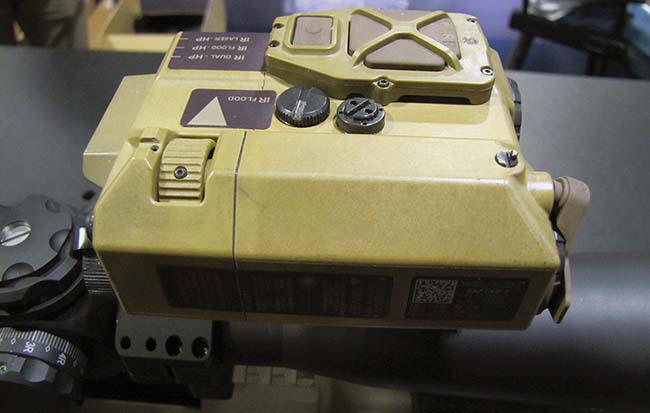
Wilcox Industries
Spirits were high at the Wilcox Industries booth, as it had been only two weeks since Jim Teetzel, Wilcox CEO, was awarded the NDIA’s highly coveted Ambrose Award. The Ambrose Award is presented to an industrial firm which, in the opinion of the NDIA Small Arms Committee Executive Board, has made outstanding contributions to the field of small arms systems. This is only the fourth time it has been awarded over the last 10 years.
The Wilcox booth boasted the weapon-mounted RAPTAR-S. This system offers an integrated ballistic computer and sensor suite to plot target acquisition and give the aim point solution for the warfighter—all with the push of a button. The RAPTAR-S weighs less than 14 ounces (0.4kg) and can be used on weapons systems from 5.56mm to .50 cal. Using a 123A lithium battery, the system is capable of more than 7 hours of run time.
To complement its infrared (IR) laser, visible laser, IR ?ood and laser range ?nder (LRF) the RAPTAR-S features an Applied Ballistics solver. Operators can use compatible mobile devices to input desired load data to RAPTAR-S for ballistic solutions. When paired with BAE thermal sights or the UTC SWIR HWH-SMS system, the RAPTAR-S provides a ballistic solution to the disturbed reticle for faster engagements. Whatever the caliber or conditions, the RAPTAR-S can calculate corrections with speed and ef?ciency, increasing ?rst round hit capability.
Halo Neuroscience
Want to shoot better? Using motor cortex stimulation technology, Halo Sport uses a process called neuropriming to heighten the brain’s natural ability to hone physical skills and make training sessions more productive. The system resembles a set of headphones, controlled by—guess what—an app. The Halo Sport sends direct current pulses to the appropriate part of the brain using Transcranial Direct Current Stimulation (TDCS), and benefits can be realized over only a 1-hour period. Does it really make shooters more accurate? According to Halo, the shooting teams from SIG and Glock are convinced and are now using the technology, as are SOF soldiers, who like them for muscle training, pain management and injury rehabilitation. According to the literature and the knowledgeable sales team, wearing the headphones for 20 minutes each day over a two to three day period will stimulate the right part of the brain to enhance muscular ability or aid in healing. Various abilities, like shooting skills, are claimed to be greatly enhanced using the technology, and the system is straightforward to use; first, the app is downloaded, then the system is briefly programmed according to the muscle group being trained and short sessions wearing the headset can commence.
FN America
FN’s primary focus for SOFIC was the SCAR-SC, a 5.56mm carbine with a 7-inch barrel that is also available in .300 Blackout. It has a non-reciprocating charging handle that is pushed forward to lock. The SCAR-SC has the normal SCAR gas piston and has an adjustment to compensate for additional gas pressure if a suppressor is used. Also displayed was the FN® Expert, a marksmanship training system for shooters and coaches. The FN® Expert is a small wireless device that attaches to the firearm and can be used for dry-fire and live-fire training together with other optics or accessories. Training is focused on fundamental shooting skills—sight picture, breathing and trigger squeeze. The FN® Expert measures rifle movement, detects the shot, shows the location of both the hit and miss and analyzes the shooter’s performance.
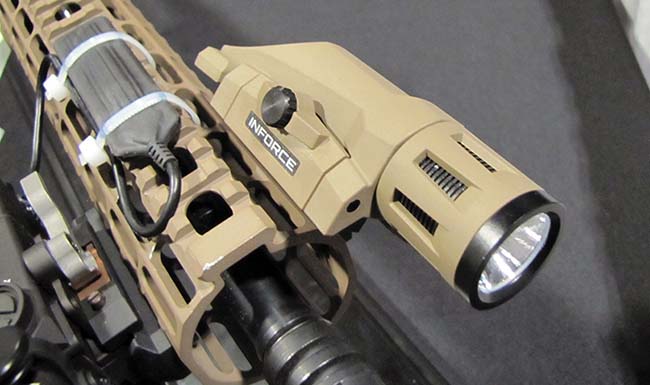
Inforce
Boasting of their all-American heritage, Inforce from Rhode Island makes a complete line of pistol and rifle flashlights. Their W-06-2 model rifle flashlight is already in use by SOCOM and is waterproof to a depth of 66 feet (20 meters). Almost all Inforce lights have built-in mounts for acceptance on a Picatinny rail, with illumination levels from 200 lumens to 800 lumens. All Inforce products are built on a polymer frame to provide a lightweight—yet rugged—construction.
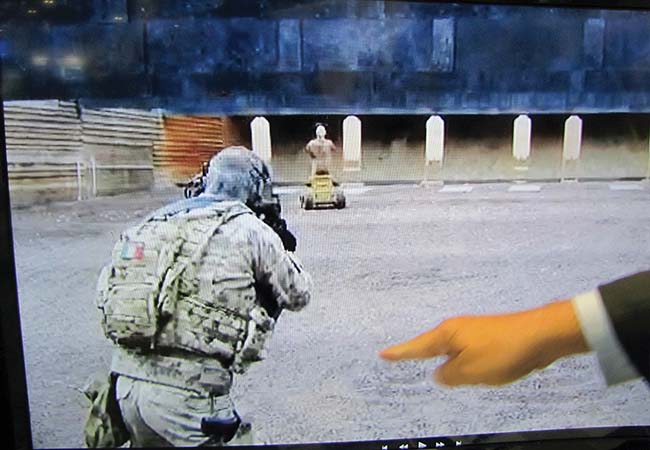
Marathon Targets
Marathon Targets has recognized the difficulty in building and maintaining firing ranges with movable targets and capitalizes on this with their lower-cost portable system. The targets are human-sized mannequins that ride on four-wheeled electric carts. Their shape, speed and motion patterns can be tailored to create lifelike combat scenarios. When a target is hit, it provides instant visual feedback as the mannequin stops and drops. Equipped with artificial intelligence, they are programmed to act like real enemy targets. As an example, when one target is “killed,” the other targets scatter for cover and later re-emerge for a counter attack.
The targets are offered as a service to the military and do not require permanent tracks. Marathon ran a film for me, in which the shooter missed the target with the last round in his rifle. At this point, the target ran toward him, forcing the shooter to draw his sidearm to engage the target. Marathon says their experience with the system has shown that, in general, soldiers and Marines have moderate effectiveness when they first try to hit these targets. However, they soon figure the lead on walking and running targets and begin making hits on targets 100, 200 and 300 meters away. After fully charging the battery of the little transporter carts, they have sufficient power to run over 25 miles (40 kilometers)—almost enough for a marathon.
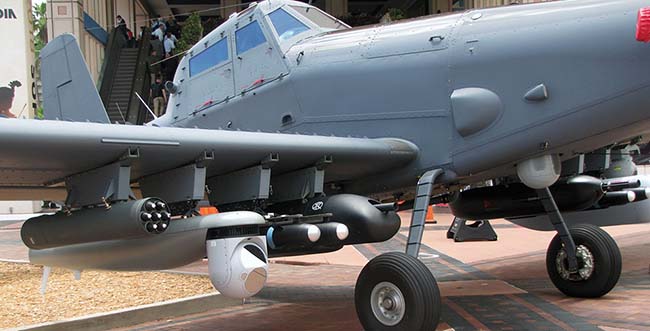
Air Tractor and Dillon
Aircraft equipped with firearms to engage ground targets are always fascinating, because they carry out one of the few tactical missions requiring high rate of fire weapons to accommodate the short time on target. The famous A-10 and C-130 are examples of systems that have proven their worth through countless military engagements and why the low-cost multi-mission AT-802L deserves a serious look. This agriculture and firefighting plane has been fully armored and repurposed as a close air support aircraft. This light aircraft can loiter for more than eight hours and has a payload capacity of more than 8,000 pounds (4,082kg). The model shown has eight stations with a mixture of gun pods, rocket launchers and intelligence-gathering or target-tracking pods. Each station can handle a 500-pound load at its hard points. There are three centerline mounts, two of which are capable of handling 1,000 pounds each.
Various gun pods, rocket launchers and electronics pods were shown mounted. The Dillon Aero Pod-6 (DAP-6) Minigun pod was the most impressive, with its clean aerodynamic look and firing rate capability of 3,000 rounds per minute. The pod fires 7.62x51mm NATO ammunition with M13 links and has a 3,000-round magazine capacity.
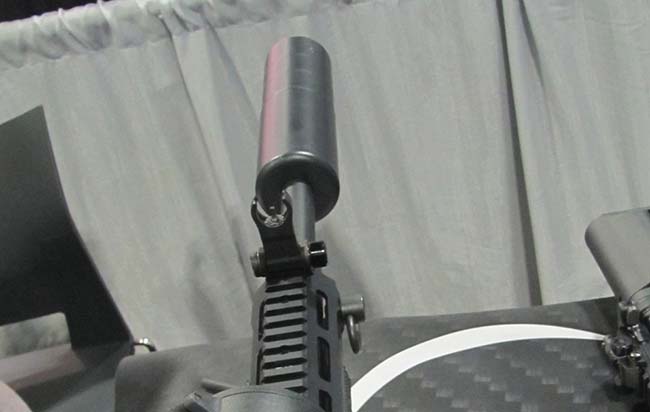
LMT
Big news from LMT is their machine gun suppressor technology, which has been obtained under license from Lawrence Livermore National Laboratory. It’s a totally new and different technology compared to traditional sound suppressors and proving to be highly effective. The suppressor can be used on machine guns, including the 7.62mm M240, but it was exhibited here on the LMT rifle adopted by New Zealand.
Accurate-Mag and Battelle
In a joint venture, Accurate-Mag (B.M.L. Tool and Manufacturing Corp.) and Battelle have perfected their Caseless Telescoping Non-Lethal Rifle. This blunt force trauma system uses a combination of a push-off piston in the projectile, which provides almost half of the muzzle velocity, and a gas jet system. The gas jet system is metered, depending on target range, to ensure that the impact velocity never exceeds 370 feet per second (113 meters per second) up to the 100-meter reported maximum range. At present, the shooter inputs the range to the target, but Accurate-Mag will be adding a scope and range finder for a seamless interface that requires the user only to aim and shoot. The military recently finished testing the system and has given it two thumbs up.
It is likely that Accurate-Mag will also be in the Advanced Sniper Rifle Program with their Advanced Multi-caliber Sniper Rifle (AMSR). The mechanism underlying the AMSR’s quick-change barrel involves a patented Trunnion barrel locking system that simultaneously tightens the barrel collar and advances two spherical locking keys into the barrel extension to complete the barrel installation procedure.

Shield Sights
Exhibiting with other companies from the United Kingdom, Shield Sights offered their Reflex Mini Sight, which they claim to be the world’s smallest, lightest and toughest mini day/night sight for military, law enforcement and sports shooters. Unlike most sights of this type, the Reflex Mini Sight is not made from plastic but is rather machined from aluminum billet. It was originally designed for use on pistols, but it is rugged enough to be used on shotguns and rifles as well.
Orbital ATK
Like the venerable Gatling gun, the Orbital ATK chain gun has served reliably through many engagements due to its external power and 100% round control. The new 30mm GAU-23 cannon was developed as an airborne weapon for gunship platforms. Orbital ATK also developed and produces the 30mm PGU-46B High Explosive Incendiary (HEI) ammunition for this gun system.
SOFWERX
Presenters from SOFWERX outlined the acquisition strategy designed to accomplish their mission: build the network, provide the venues and develop the tools and processes to enable agile SOF acquisition. The time and effort they have put into educating the warfighter on what technologies are available and streamlining acquisition show that they are really serious about getting the latest equipment to the USSOCOM. Their logistics center, SOFWERX, uses new tools to acquire advanced technology faster than the current traditional acquisition process. SOFIC participants were encouraged to sign into the system to make their technologies known and to help solve challenging warfighter problems through increased collaboration and innovation. Not limited to just the USSOCOM, our international partners are also finding that their performance is improved when they have U.S. equipment. To that end, SOCOM has entered into agreements with allies to transfer many of our products to them.



